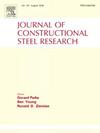Plug-in seismic isolation joints in modular steel structures: Experimental and numerical evaluation
IF 4
2区 工程技术
Q1 CONSTRUCTION & BUILDING TECHNOLOGY
引用次数: 0
Abstract
This paper introduces an insertable seismic-isolation and energy-dissipation connection joint tailored for modular steel structure buildings. To explore the seismic isolation and energy-dissipation performance of this innovative joint, cyclic loading tests were conducted on a two-story steel frame model equipped with the proposed joints. This study systematically analyzed the deformation patterns and seismic behaviors of the joints and established a mechanical model through theoretical analysis. The test results show that the proposed joints exhibit excellent energy dissipation and damping capabilities, which enables them to enhance the seismic resistance of modular steel structures effectively. In addition, the ETABS software was used to conduct modal decomposition response spectrum analysis and time-history analysis on a modular building. The simulation results show that introducing seismic isolation joints increases the average natural period of the structure under seismic action by 244%. Further analysis reveals that the isolation structure has a more significant damping effect on the lower floors compared to the non-isolation structure, and the damping effect under rare earthquakes is better than that under design earthquakes. Although the calculation results of the time-history analysis method are more conservative than those of the modal decomposition response spectrum method, both methods indicate that the new seismic isolation joints have a significant damping effect and can effectively improve the seismic performance of the structure under seismic action.
组合式钢结构插入式隔震缝:试验与数值评估
介绍了一种适用于模块化钢结构建筑的可插入式隔震耗能连接缝。为探索该节点的隔震和耗能性能,对安装该节点的两层钢框架模型进行了循环加载试验。本研究系统分析了节理的变形模式和抗震行为,并通过理论分析建立了节理的力学模型。试验结果表明,所提出的节点具有良好的耗能和阻尼能力,能够有效地提高模块化钢结构的抗震性能。此外,利用ETABS软件对某模块化建筑进行模态分解响应谱分析和时程分析。仿真结果表明,引入隔震缝可使结构在地震作用下的平均自然周期提高244%。进一步分析表明,隔震结构对较低楼层的减震作用比非隔震结构更显著,在罕见地震作用下的减震效果优于设计地震作用下的减震效果。虽然时程分析法的计算结果比模态分解反应谱法的计算结果更为保守,但两种方法都表明,新型隔震节点具有显著的阻尼作用,可以有效地提高结构在地震作用下的抗震性能。
本文章由计算机程序翻译,如有差异,请以英文原文为准。
求助全文
约1分钟内获得全文
求助全文
来源期刊

Journal of Constructional Steel Research
工程技术-工程:土木
CiteScore
7.90
自引率
19.50%
发文量
550
审稿时长
46 days
期刊介绍:
The Journal of Constructional Steel Research provides an international forum for the presentation and discussion of the latest developments in structural steel research and their applications. It is aimed not only at researchers but also at those likely to be most affected by research results, i.e. designers and fabricators. Original papers of a high standard dealing with all aspects of steel research including theoretical and experimental research on elements, assemblages, connection and material properties are considered for publication.
 求助内容:
求助内容: 应助结果提醒方式:
应助结果提醒方式:


